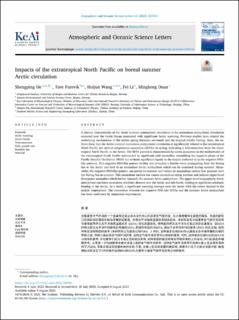| dc.contributor.author | He, Shengping | |
| dc.contributor.author | Furevik, Tore | |
| dc.contributor.author | Wang, Huijun | |
| dc.contributor.author | Li, Fei | |
| dc.contributor.author | Duan, Mingkeng | |
| dc.date.accessioned | 2024-02-14T11:31:28Z | |
| dc.date.available | 2024-02-14T11:31:28Z | |
| dc.date.created | 2023-09-20T10:00:48Z | |
| dc.date.issued | 2023 | |
| dc.identifier.issn | 1674-2834 | |
| dc.identifier.uri | https://hdl.handle.net/11250/3117486 | |
| dc.description.abstract | A distinct characteristic of the Arctic summer atmospheric circulation is the anomalous anticyclonic circulation centered over the Arctic Ocean associated with significant Arctic warming. Previous studies have related the underlying mechanisms to the earlier spring Eurasian snowmelt and the tropical Pacific forcing. Here, the authors show that the Arctic summer anomalous anticyclonic circulation is significantly related to the extratropical North Pacific sea surface temperature anomalies (SSTAs) in spring, indicating a teleconnection from the extratropical North Pacific to the Arctic. The SSTA pattern is characterized by warm anomalies in the midlatitudes of the extratropical North Pacific surrounded by significant cold anomalies, resembling the negative phase of the Pacific Decadal Oscillation (PDO) but without significant signals in the tropics (referred to as the negative PDO-like pattern). This negative PDO-like pattern in May can stimulate a Rossby wave propagating from the Bering Sea to the Arctic and lead to an anomalous Arctic anticyclone which can be sustained during summer. Meanwhile, the negative PDO-like pattern can persist to summer and induce an anomalous surface low pressure over the Bering Sea in summer. This anomalous surface low causes anomalous rising motions and induces upper-level divergence anomalies which further intensify the summer Arctic anticyclone. The upper-level tropospheric Arctic anticyclone can force anomalous adiabatic descent over the Arctic and sub-Arctic, leading to significant adiabatic heating in the Arctic. As a result, a significant warming emerges over the Arctic with the center located in the middle troposphere. The connection between the negative PDO-like SSTAs and the summer Arctic anticyclone has been confirmed by numerical experiments. | en_US |
| dc.language.iso | eng | en_US |
| dc.publisher | Elsevier | en_US |
| dc.rights | Attribution-NonCommercial-NoDerivatives 4.0 Internasjonal | * |
| dc.rights.uri | http://creativecommons.org/licenses/by-nc-nd/4.0/deed.no | * |
| dc.title | Impacts of the extratropical North Pacific on boreal summer Arctic circulation | en_US |
| dc.type | Journal article | en_US |
| dc.type | Peer reviewed | en_US |
| dc.description.version | publishedVersion | en_US |
| dc.rights.holder | Copyright 2023 The Author(s) | en_US |
| dc.source.articlenumber | 100405 | en_US |
| cristin.ispublished | true | |
| cristin.fulltext | original | |
| cristin.qualitycode | 1 | |
| dc.identifier.doi | 10.1016/j.aosl.2023.100405 | |
| dc.identifier.cristin | 2176873 | |
| dc.source.journal | Atmospheric and Oceanic Science Letters | en_US |
| dc.identifier.citation | Atmospheric and Oceanic Science Letters. 2023, 16, 100405. | en_US |
| dc.source.volume | 16 | en_US |

